Problems and Limitations of Animation
Beyond the problem of split attention mentioned above, psychologist Barbara Tversky and her colleagues have identified four major challenges when people watch and learn from animated graphics (including maps) as compared to the static graphics of the same data: Attention: In any visually rich display, especially in an animated map where many things can be happening simultaneously, readers are often […]
Nontemporal Animated Maps
Animated maps do not have to depict temporal data. One kind of a nontemporal animated map is a fly over map that simulates the experience of 'flying' over a digital landscape or zooming into or away from a location (as is possible with Google Earth). Most often with fly overs the map itself is static (e.g., the colors of the […]
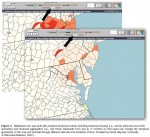
Temporal Re-Expression, Filtering, and Interpolation
Although the most obvious way to animate spatiotemporal data is to simply play the data in the same sequence as it was collected (e.g., day 1 – frame 1, day 2 – frame 2, and so on), this is not always very insightful because: (1) the data may be very complex and contain multiple meaningful patterns, and/or (2) the […]
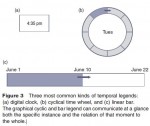
Temporal Animated Maps
Static maps present all of their information simultaneously; animated maps present information over time. Thus, animated maps have an additional representational dimension that can be used to display information. While it obviously takes time for a reader to scan a paper map, such as retrieving specific rates, the overall or holistic impression of the map happens at a glance. Moreover, […]
History of Animated Maps
The history of animated maps is very much tied to the history of computers. Early examples of animated maps were produced in the 1930s using hand drawn, cel based techniques borrowed from cartoon animation. Because these manual techniques were exceptionally time consuming, academic cartographers and computer scientists started experimenting with the potential of computer assisted animation surprisingly early (late 1950s) and […]
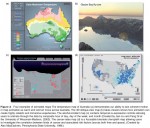
Cartographic Animation
Animated maps, sometimes called movie maps or change maps, are primarily used to depict geographic change and processes. Cartographers have long been interested in the potential of map animation because representing complex geographic processes on static maps is a significant challenge. Put simply, animated maps are appealing because we live in an animated world. Humans also possess an eye–brain system […]
Cartography and Surveying in Iran in the Twentieth Century
In the twentieth century, cartography developed in Iran in three sectors – private cartographic and surveying companies, the army, and governmental civil institutions. The first private cartographic company, Sahab Geographic & Drafting Company, was founded in 1315 h sh/1936 by 'Abdolghasem Sahab (1265–1335 h sh/1886–1956) and led for most of the century by his son 'Abbas Sahab (1300–79 h […]

Functions and Purposes
Maps, charts, plans, diagrams, and tables served a variety of functions and purposes in Islamic societies although the bulk seems to have spent their life in manuscripts, that is, in the spheres of educated readers. The earliest usage of maps seems to have happened when the armies of the newly converted Arab tribes invaded regions of Iran and Central Asia. The […]
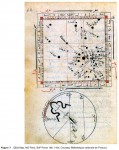
Cartographic Genres and Practices
In addition to the world and regional maps, portolan charts, and handbooks for sailing directions discussed in the previous section, a number of other cartographic formats were developed in Islamic societies. Early in the ninth century, or perhaps even in the eighth century, the question of how to determine from any given place the direction toward Mecca was raised. David A. King […]
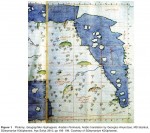
Cultures of Mapmaking
Mapmaking in Islamic societies took its themes, methods, techniques, and formats from several societies that either existed before the emergence of Islamic societies or parallel to them. The regions where these societies flourished were Greece, Egypt, Iran, India, China, Spain, Italy, the Netherlands, and France. With the shifts and changes in Europe since the sixteenth century, further European societies became relevant […]
Cartography in Islamic Societies
In Islamic societies, cartographic activities were part of courtly patronage and diplomatic exchange, educational literacy and scientific study, religious rituals and reminiscence, entertainment and the arts, and to some extent of war, seafaring, and administration. Many of the extant cartographic products are parts of manuscripts. Words, narratives, numbers, tables, and geometrical figures organize, structure, delineate, and interpret them. Books […]
Historical Cartography
A second form of geographical and historical investigation about the past involves maps compiled from data relating to an earlier situation. Interpreted generously as the writing of history with maps rather than words, the practice is older and the reasons for it more diverse than is generally described. In the thirteenth and fourteenth centuries, for example, maps of the world […]
The History of Cartography
The division of the history of cartography into 'old' and 'new' came about in the penultimate decade of the twentieth century. Examples of the use of the word 'cartography' in Germany as early as the second decade of the nineteenth-century have been found, but the idea of a formal history of cartography for the study of old, that is, nonmodern, maps […]
The History of Maps and Mapping
That new approach emerged in the 1980s, propelled by factors both external and internal. External to – one might say foreign to – the world of cartography was the French theoretical and philosophical post structuralist movement led by Michel Foucault and Jacque Derrida that had already found fertile ground in the humanities (including geography) in Europe in the late 1970s. […]
Cartometrics
Cartometrics, which involves the detailed assessment of the mathematical structure (geodetical accuracy) of a map, is still in its infancy as a potentially powerful tool in the historical study of early maps. The modern emphasis on understanding the social context from which a map emerged does not in any way exclude the need to understand also the technical processes of map […]
Cartobibliography: The History of Printed Maps
The indispensable step in approaching a map (or anything) to be used as evidence is to check its publication history and its credentials as a source in the same way as a bibliographer examines a book. The discriminating description of maps is known as cartobibliography, a term first used in 1914 by George Fordham in the title of […]
Infrastructure
Despite the relevance of maps to many fields of historical study in the humanities and the social sciences, academic responsibility for the study of early maps has tended to be nobody's business. Full length university courses are rare (there are at present only two professorial chairs in the subject in the world, both in the USA). A promising new development at […]
Approaches to the History of Cartography
For geographers, the relationsip between maps and history has taken several forms. The terms used to describe each form are not synonymous; the 'history of cartography' is not the same thing as 'historical cartography' or the 'history of mapping', although in practice the boundaries between the categories of activities noted below are neither precise nor impermeable. Many studies conducted under […]
Cartography, History of
The ubiquity of maps today is beyond dispute. They are treasured as decoration in private and public places, and enjoyed in exhibitions. Whether in manuscript or print, or on television, maps are the workhorses of weather forecasters, reporters, political and cultural commentators, cartoonists, textbook writers, scientific researchers, administrators, and planners alike. As printed road atlases (or, increasingly, electronic satellite navigation systems), they […]
Issues and Challenges of the Case Study Approach
Use of the case study approach in both teaching and research has been criticized for more than five decades. Indeed, unlike this reference book, many research and pedagogy guidebooks fail to include the case study approach in their discussions. The reasons for this are twofold. First, case study research has been criticized for: (1) its unscientific nature (because findings cannot […]
Using the Case Study Approach to Teach Human Geography
Case studies are useful not only in research, but also in classroom instruction in human geography. One of the many strengths of this type of teaching and learning is that it is one of the most effective ways to link research and teaching in geography classrooms at all levels of instruction. During the past decade, a spate of books and articles […]
Methods Useful in Case Study Research
Particular attention must be paid to considering how best to test for reliability and validity when assembling the methods used to conduct case study research. One of the best ways to accomplish this is to use multiple sources of evidence including the use of such approaches to data gathering as interviews, survey questionnaires, field observation, textual analysis, participant observation, analysis […]
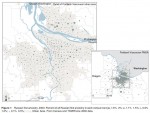
Types of Case Studies
At least five different types of case studies have been discussed in the geography and social science literature: intrinsic, collective, explanatory, descriptive, and exploratory. In each of these types, there may be single case or multiple case approaches used. An intrinsic case study is defined as research wherein the researcher has a (personal or professional) interest in the project. In […]
Case Study Approach
The case study approach in human geography is useful in both research and teaching, particularly when an in depth investigation is needed. The study of a single place, a particular group, or a specific issue in one location is helpful in narrowing down research topics. Such topics are often more manageable and meaningful for both early career geographers and more experienced […]
Capital’s Consumption Spatiality
Capital makes space not just for accumulation. Spaces of consumption are also important without which value will not be realized. But spaces of consumption are also usevalues that labor demands. For example, housing is an important working class demand. Capital, however, uses it as a means of investment: housing and the like can absorb a lot of surplus capital staving […]
Capital and Space: Capital’s Crisis-Spatiality
Capital accumulation and its relation to space cannot be looked at without a serious attention to the contradictory character of capital. There are four major types of contradiction. Each of these is a dimension of the main contradiction: the contradiction between social relations and productive forces under capitalism. The use of space is crucial to the partial alleviation (or temporary […]
Capital and Space: Capital’s ‘Normal’ Spatiality
Each phase in the circuit of capital has a corresponding spatial form. There are thus spaces of production, spaces of realization (capital realizes the surplus or profit when the product is sold), and spaces of accumulation (where a part of the surplus/profit is reinvested). An interesting aspect of these spaces is the mutual incongruence between these spaces: commodities produced in […]

How Does Capital Work?: Mechanisms of Capital
To understand how capital works, the author returns to Marx's general formula for capital as he outlines in chapter 4 of Capital vol 1: M–C–M0, which can be expanded into: M … C [MP, LP] … P … C0 …M0 (see Figure 1). The general formula means that: the owner of capital invests money (M) to buy commodities (C) which include means of production […]
Capital and Space
Tools, machines, and other types of means of production are considered to be capital in many conventional economic geography texts. In this view, capital is not only a tangible thing but also a transhistorical thing. In a slightly more general view, capital is defined as any incomegenerating asset that generates some benefit, including income. Using capital metaphorically, scholars talk […]
Business Service Geographies – Global Cities, Service Offshoring, and the Second Global Shift
Global Cities Business services have a complex geography that reflects the existence of concentrations of clients in major cities or in the global cities of London and New York. Business services have been growing rapidly not only in the major cities, but also in locations further down the urban hierarchy and even in rural locations. Conventionally, it has been assumed […]
Business Services – the Body and Emotional Labor
Successful business service entrepreneurs possess three important attributes: professional expertise, an existing reputation (sometimes iconic), and a network of client contacts. These essential requirements for competitive success explain the concentration of founders' previous employment in same sector or client firms, and into larger rather than smaller companies. The founders of business service firms acquire their reputations, expertise, and client contacts while working for […]
Explaining the Growth of Business Service Firms
The tendency for firms to externalize or outsource functions and activities previously produced in house (internalized) is one of the best known hypotheses used to explain the rapid relative growth of business services. It has its origins in research on the importance of complementarity and economies of scale for decisions by firms about whether to externalize or internalize service functions. The […]
Characteristics of Business Service Firms
The growth in employment in business services was also reflected in extremely high rates of new firm formation. Business services were the main contributors of UK small firm service sector growth in the 1980s and 1990s. Not only were business service growth rates generally slightly higher than those for consumer service sectors, but business services generated nearly 3 times as […]
Measuring Business Services in National Economies
The ongoing structural realignment being experienced by economies makes it impossible for governments to ensure that their national economic statistics are an adequate reflection of economic activity. This has always been the case. The UK Standard Industrial Classification of Economic Activity (SIC) is a measure of economic activity, but essentially it is a backward looking measure; the SIC cannot be constantly […]
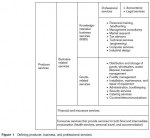
Defining Business Services
The academic literature on business services has its foundations in a ground breaking monograph published by Harry Greenfield in 1966. In this classic work, Greenfield argued that the consumer/producer dichotomy with respect to goods could also be applied to services. Consumer goods are produced to satisfy final demand while producer goods (machine tools, etc.) are intermediate inputs that contribute to […]
Business Services
Developed market economies have been experiencing a process of structural change over the last two decades that has involved two related alterations. First, a process of de industrialization in which manufacturing's share of employment and output has been declining and, second, compensating growth in employment and output in services and especially in business services. Business services add value to their […]
New Issues
The international frontier carries memories of past tensions that are related to the persistence of geographical factors or to the inertia of cultural geography. With the end of the Cold War, many parts of this international frontier became destabilized again. The return of war to Europe has led to ethnic cleansing, diminishing again the potential of many areas to function […]
Buffer Zones and the International Frontier
Global and Large-Scale Outlooks At a high level of geopolitical generalization, buffer zones appear as separating large areas unified by religion, empire, ideology, or culture. With the rise of Islam, the Mediterranean Sea became a buffer zone between Christian Europe and Muslim North Africa. Charlemagne's empire, divided in three parts at Verdun in AD 843, led to a historical buffer […]
Buffer States
A buffer state is a relatively weak state lying between two or more antagonistic powers of comparable potential. Conditions for Buffer State Status The geographical condition seems paramount. The buffer state must be in contact with the territory of the other powers and must separate them. However, this separation may not be complete. Thus, for example, the fact […]
Buffer Zones as Peripheries of Territories
Ideally, buffer zones are neutral spaces between two or more territories. However, in many cases, buffer zones were organized by one power in order to cope with challenges or in order to take advantage of opportunities coming or existing in spaces dominated by less organized powers. In such situations, buffer zones are in fact peripheries of the territory of the […]
Buffer Zone
In its simplest definition, a buffer zone is an area between two or more adversarial powers, whose function is to physically separate them. It is thus conceived as an instrument of peace and stability. The word buffer conveys the idea of absorption of tensions, of cushioning. A buffer zone can exist at various geographical scales, in accordance with the […]
Tensions and Complementarities between the Green and Brown Agendas
Tensions clearly do exist between the brown agenda and the wider green movement. Indeed, it was partly due to a perceived neglect of local urban environmental issues by green organizations that urban development authors and practitioners started using the term brown agenda. However, solutions to brown agenda problems can be problematic from a green perspective – it is sometimes the case that […]
Main Elements of the Brown Agenda
Water Supply Access to safe water and sanitation are two of the most urgent problems associated with the urban environment in the developing world. Globally, 1.1 billion people do not have access to adequate water supplies and more than double that figure – 2.4 billion – lack adequate sanitation facilities. These problems are particularly acute for the urban poor in many […]
What Is the Brown Agenda?
In brief, the brown agenda refers to issues of safe water provision, sanitation, and drainage; inadequate solid and hazardous waste management; and air pollution including uncontrolled emissions from motor vehicles, factories, and low grade domestic fuels. The brown agenda emerged as a matter of concern and debate, in part, because of a perceived lack of attention to the specifically urban environmental […]
Brown Agenda
With the increasingly high profile of global environmental concerns from the 1980s, the urban agenda for developing countries has seen progressive shifts toward a focus on urban environmental issues, collectively termed the 'brown agenda'. The most critical and immediate development issues facing cities of the developing world – those of water supply, sanitation, and waste management – were reconceptualized through an […]
An Evaluation of the Recommendations of the Brandt Commission
Behind the individual measures called for by the Brandt Commission, there were two key dimensions. The first was a need for the large scale transfer of resources to the countries of the South. The second was the recognition of the global mutuality of development and the need to act on such interdependence. In both these senses, the Brandt Commission's recommendations were […]
The Principal Recommendations of the Brandt Commission
In a passage that today seems remarkably prescient, the Commission's Report North–South clearly pinpointed what it saw as the principal threats to global order: If reduced to a simple denominator, this Report deals with peace. War is often thought of in terms of military conflict, or even annihilation. But there is a growing awareness that an equal danger might be […]
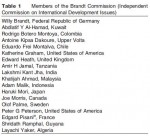
Membership of the Commission and the Schedule of Meetings
Willy Brandt regarded it as essential that the Commission was independent and that its members, no matter their background, should be invited to serve in a strictly private capacity. The Commission also wanted to ensure that the majority of its members were drawn from what were frequently described at the time as Third World (Southern) countries. The eighteen commissioners are […]
Brandt Commission
Introduction: Background to the Independent Commission on International Development Issues (the Brandt Commission) and Its Report (the Brandt Report) The Brandt Commission, properly known as the Independent Commission on International Development Issues (ICIDI), was established in 1977 with the express aim of examining the world's development needs in the 1980s and beyond. In the words of the Commission's Report, the intention was to […]
Lack of Data
Hampering the ability to understand global patterns of skills migration and to develop policy responses is a lack of reliable information. There is a critical absence of hard data on migrant stocks and flows, their human capital content, and the actual impacts (negative and positive) of skills migration from particular developing countries. A recent exception is an econometric study on the […]
Global Cooperation
Despite the conflict of interests at the table, there are signs of cooperation. The United Kingdom and the Commonwealth have developed protocols to address the recruitment of healthcare workers and teachers from developing countries. As well, the General Agreement on the Trade in Services (GATS) may open the door to a more coordinated and mutually beneficial international mobility of skilled workers. The […]
Policy Prescriptions and Possibilities
With the international mobility of highly skilled workers forecast to increase, many countries and regional groupings of states are taking steps to coordinate and implement policy responses. Most authors agree that countries must do away with a laissez faire approach. Strategic immigration and development aid policies must be developed, aimed at effective management of human capital that produces a win win situation […]
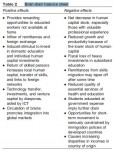
Feedback Effects
Adherents of the revisionist approach emphasize the positive potential of skills out migration for Africa, Asia, and Latin America. The loss of the highly skilled may not always mean a loss for economic development. The revisionists assert that brain drain is a temporary stage and that a brain gain may actually result. Along with the migrant and receiving country, the […]
Impacts of Brain Drain
What does it mean for Asian, African, and Latin American countries that lose skilled professionals to developed countries? Traditionally, skills out migration has been seen as an unqualified negative for these countries; the very term brain drain suggests as much. Certainly the general tenor of current policy thinking is that skills migration produces a general 'brain strain' on development. While information technology […]

Global Patterns of Brain Drain
Each region, country, and sector exhibits different patterns of skills loss and gain, but some global patterns have been discerned in the statistics. The emigration rate among the tertiary educated has been estimated at 41% for the Caribbean region, 27% for Western Africa, 18% for Eastern Africa, and 16% for Central America (see Table 1 for figures by African countries). […]
Toward a Definition
Among the terms often used to describe skills migration, brain drain is the most prevalent. The term skills migration is employed in this article instead of the more commonly used skilled migration in order to indicate a migration or movement of embodied skills instead of incorrectly suggesting that migration has or can have skills. The term brain drain was coined […]
Brain Drain
Introduction – Not Just Drains and Gains The globalization of international migration has greatly enhanced the international mobility of people with skills. In a global skills market, skills (rather than citizenship and nationality) are the passport to movement from one country to another. Skills do not move evenly across space, however. Underlying current geographical patterns of skills migration are profound […]

Bowman, Isaiah (1878–1950)
Isaiah Bowman was arguably the most influential American geographer of the twentieth century, serving as the ambassador of the discipline to policymakers and the nation at large (Figure 1). Born in 1878 and educated at Harvard and Yale, he began his career with a research focus on geomorphology but soon became interested in human–environment interactions, particularly in the Andes Mountains. He led […]
Current Research Issues
Over the past 20 years, we have witnessed an exponential growth of border studies, predominantly in Europe and North America. The enlargement of the EU in 2005 brought about a change in the meaning and permeability of the Union's internal and external borders, while 9/11 resulted in putting the meaning of the outer borders of the US into a new geopolitical […]
Borderlands and Border Identities
History and the collective memory of a population are sometimes stronger reference points in the construction of identity than regulations and restrictions. Above, the regional identity of the Austrian–Italian borderland population was highlighted. While the border and with it the political regime changed several times over the past century, the population continued to identify with local customs and was also able to […]
Borderlands as Everyday Spaces
Above, borderlands were discussed primarily as cross-border spaces, because the (inter)dependency between both sides of the border is usually very high, which is also true in everyday life. In borderlands, distinct everyday (inter)action spaces can be observed. The population copes with its given realities, which are greatly determined by a number of factors: binational relations, national border policies, the overall economic situation, […]

Borderlands as Functional Spaces
Borderlands are not always marginal or peripheral areas that are poorly developed with bleak economic perspectives. They can also be places that function dynamically, with a high density of shopping centers and industrial production facilities resulting in job opportunities for locals and migrants. Further, borderlands are frequently characterized by a high degree of interdependency among regions within their […]
Borderlands as Normative Spaces
Borderlands are territories that are subordinated to a certain national regime and are therefore subject to the norms of its specific political system. Hence along a border, two extremely different political systems may meet if subjected to extremely different political norms. This is best illustrated through the example mentioned above of North and South Korea. However, in numerous cases borderlands are also […]
The Dependency of Borderlands on Binational Relations
Central governments usually oversee borderlands, which means that border related issues are considered a matter of foreign affairs. Several exceptions, however, such as the Italian Trent South Tyrol region, enjoy a certain degree of autonomy. Even though borderland populations are those who deal with their neighbors on a daily basis, they usually have few or no rights to decide on issues […]

The Permeability of Borders
Permeability, the degree of openness of borders, is of crucial importance for people living in borderlands. The twentieth century saw each type of border regime: closed, semipermeable, and permeable. Some border regimes even ceased to exist, at least in one certain respect, for example, in economic terms. In Europe, the Iron Curtain was experienced as an insurmountable barrier. Inhabitants on […]
Borderlands
Borderlands are spaces where normative systems meet. This can mean that the border is a barrier, hindering and controlling cross border activities and contacts, which has a clear impact on the adjacent borderlands. Borders can also function as bridges with the implication for the residents in the borderlands that they can benefit from the differences in the neighboring states and develop specific […]
Corporeal Geographies
The growing scholarship in corporeal geography is evident in the vast range of studies and approaches to understanding the body. One of the most popular approaches, for geographers and other social scientists, continues to be the cultural inscription approach which draws on post structuralist theories to understand the body as a surface to be etched by cultural and social systems. […]
What Is the Body?
'The body' is often treated as a taken for granted entity that needs no explanation. We all have bodies; however, how and where we use our bodies varies greatly. Bodies are used to ground personal identity and to recognize other people's identity. Bodies are used for the assignment of various roles, tasks, and strategies, for practical action, for reproduction, and […]
Mind/Body Dualism
The seventeenth century philosopher Rene Descartes established a dualistic concept of mind and body.Western rationalist tradition entails a radical separation of body and mind that accords primacy to the mind. Descartes argued that the mind had the conceptual power of intelligence and hence selfhood. The corporeal body was deemed to be a vehicle which could be directed by the mind. This […]
Body, The
The body is a crucial site of sociospatial relations, representation, and identities. It is the place, location, or site of the individual. It is also a site of pain, pleasure, and other emotions around which social definitions of wellness, illness, happiness, and health are constructed. The body is the location of social identities and differences such as gender, sexuality, […]

Bobek, Hans (1903–1990)
Born in Klagenfurt, Bobek's (Figure 1) studies at the University of Innsbruck (1921–26 – geography, history, social sciences) established two key areas of research. On the one hand his dissertation about Innsbruck (Innsbruck, eine Gebirgsstadt, ihr Lebensraum und ihre Erscheinung) established his later interest in urban research as well as in central place theory. The other field of research derived from […]
Biopolitics
Biopolitics and Place Horizontal Fix Geography and Biopower
Geography and Biopower
The sociospatial view of biopolitics is based on the understanding of power as a web of dependencies emerging in and through the constantly evolving settings of human communities and associations. Power grows from within individual and collective initiatives, reactions, and proactions under the fluid conditions of general change. Power has in this view thoroughly permeated our social practices and it […]
Horizontal Fix
The idea of nonlocal biopolitics seems reasonable as a provocative means to influence the attitudes toward globalization and especially its neoliberal features. It functions as a warning for the direction that the humanity as a whole has taken. However, nonlocalism also seems to rise from the type of thinking that connects spatiality with traditional or early modern territorial practices of power. The […]
Biopolitics and Place
Biopolitical interpretation of society is connected to the debate on the changes of life and work conditions in a world where precarious social relations prevail. It underlines the radical mixing of private and public spheres of life, emerging for example in the form of constant reorganization of families and communities under the pressure of neoliberal globalization. Human beings, both as […]
Key Challenges within Biodiversity Mapping
Despite important advances in biodiversity mapping, there remains a variety of critical debates surrounding biodiversity mapping approaches. A key issue is the challenge of collecting and combining appropriate data with which to make conservation decisions. A lack of appropriate data has led to questions over the validity of results, particularly in the contexts of developing countries and the biodiverse tropical regions […]

Biodiversity Mapping: History
The mapping of species distributions has a long history in geography. As far back as the early 1800s, Alexander von Humboldt described the latitudinal and altitudinal distributions of vegetation zones, and others continued such practices until methods were eventually formalized within the subdiscipline of biogeography. In other disciplines, too, particularly biology, the notion that place matters in ecological processes and patterns […]
Biodiversity Mapping
The term 'biodiversity mapping' encompasses a variety of techniques used to represent and analyze patterns of biodiversity, and is almost always used within the framework of environmental conservation. Although maps of biodiversity can be useful simply as a way to represent complex environmental data in an easily interpretable form, usually biodiversity mapping involves further analysis and manipulation of the data in […]
Key Issues and Critical Perspectives
Biodiversity touches nearly every aspect of human affairs in the twenty first century, including environmental sustainability, poverty and social justice, medicine and healthcare, agriculture and food, and economic globalization. As a consequence, a wide range of critical assessments of the concept has emerged, ranging from questions of who should own, control, and benefit from biodiversity to questions of how to […]
The Geography of Biodiversity
Geography is critical to understanding biodiversity. First, biodiversity is unevenly distributed over the surface of the Earth. In general, species diversity increases toward the equator, with the world's most species rich habitats occurring in the belt of tropical moist forests that falls between the Tropics of Capricorn and Cancer. Tropical moist forests are the most species rich terrestrial habitats, covering only 7% […]
The Biodiversity Crisis
Scientists, conservationists, and hunters have been concerned about species extinction, primarily vertebrate species, at the local and regional scales for decades. Toward the end of the nineteenth-century in North America and Europe, bird plumage on hats was a dominant middle class fashion statement. Exotic and colorful bird feathers were in great demand. As a consequence, many bird species were hunted […]
Biodiversity
Biodiversity, a contraction of biological diversity, is a recently invented term whose origins are readily traceable. The invention of the term 'biodiversity' coincides with the emergence, in the 1980s, of two new scientific fields, genetic engineering and conservation biology. Technological advances in genetic engineering resulted in the commodification of genetic material as a natural resource, the raw material for a new […]

Berry, Brain J. L. (1934–)
Brian Joe Lobley Berry (Figure 1) was born in Stafford, England on 16 February 1934, received his BSc in economics and geography from University College, London in 1955 and his MA (1956) and PhD (1958) in geography from the University of Washington, and is the Lloyd Viel Berkner Regental Professor and Dean of the School of Economic, Political and Policy […]
Berkeley School
Defining the Berkeley School The Berkeley School is a collective term applied to the geographers and their publications that emanated from the work of Carl Sauer (quod vide) and the colleagues and postgraduate students taught by him during his long term as head of the department of geography at Berkeley from 1923 to 1955. By extension it must also include […]
Belonging
The Politics of Belonging Locating Geographies of Belonging Place, Identity, and Belonging Globalization and Belonging
Globalization and Belonging
Consideration of the impact of globalization on our sense of belonging in the world necessitates a multiscalar analysis of concurrent and yet radically uneven processes that take place across global, national, and local contexts. For instance, it is increasingly common for the compression of time and space (a key feature of globalization that geographers address) to be linked with […]
Place, Identity, and Belonging
Geographers approach the politics of place and relate it to identity and belonging in a double move. First, the proliferation of situated studies of identity events in different places provides an ongoing insistence and reminder that place matters. Underlying this insistence is the understanding that things turn out differently in different places, or in other words, that place makes a difference. […]
Locating Geographies of Belonging
Like many of the currents of contemporary social issues, the politics of belonging is not exclusively studied within human geography. Neither is it represented within this, or any other discipline, as a discrete body of work. Rather, issues of belonging emerge from a slip stream of interdisciplinary conversations. They are threaded within and across the related topics of identity, citizenship, […]
The Politics of Belonging
The fact that geographers now consider belonging as an issue of disciplinary interest is indicative of the increasingly fluid, uneven, and above all contested terrains of identity politics and social relations in the early twentyfirst century. Along with the unsettling of fixed and coherent identities associated with the relatively predictable concerns of early modernity, it is becoming more and […]
Prospect
These active areas of research reflect at least some degree of continuity with the project that began in the 1960s as a corrective to spatial science and that became an important catalyst for new waves of research that sought to put the 'human' back into 'human geography'. The current outlook for behavioral geography sensu stricto, however, reflects its […]
Continuity and Marginality
Naturally, the process of marginalization was not immediate. Behavioral geography, albeit now defined sensu stricto as the 'cognitive science' strand, retained its adherents. Its future within academic geography after 1980, however, varied from country to country according to factors such as national research traditions and the extent of institutional support. In Europe, for instance, behavioral geography had only ever […]
Critique
These brief summaries of three representative areas of research within behavioral geography by no means exhaust a field of inquiry that addressed problems of cognition and behavior at all levels from microspace to cosmology in environments ranging from polar tundra to inner areas of metropolitan cities. Not surprisingly given this diversity and the uneasy coexistence of separate schools of thought, […]
Attachment to Place
Interest in attachment to place was not confined to natural hazards research. Cognitive mapping studies had repeatedly shown the significance of attachment to place by revealing the way in which the home and the home neighborhood served as anchoring points in patterns of spatial knowledge and activity. Attention to attachment to place was also an important point of convergence for the […]
Natural Hazards
The fact that people continue to live in places at risk from hazardous events, where 'objective analysis' might be presumed to suggest safer alternative locations, provided the rationale for another strand of cognitive behavioral research by geographers. Natural hazards research combined the geographer's interest in physical environmental processes that apparently lie outside human control with the desire to understand complex patterns […]
Cognitive Maps
The term 'cognitive map' derives from a paper written by Edward Tolman in 1948. Entitled 'Cognitive maps in rats and men', although mainly about rats, it put forward the idea that the rodents built up so called 'cognitive maps' over time that enabled them to steer their way about their environments. Tolman compared the rat's brain to the central office of […]
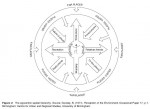
Consolidation
As with many embryonic fields of study, the work of the pioneers was followed by extensive efforts to consolidate knowledge. A supportive infrastructure of discussion groups and symposia developed first in North America, with the subsequent foundation of newsletters, journals, and edited collections allowing wider dissemination of materials. For example, the first symposium on 'environmental perception and behavior', held at the […]
Early Development
The 1960s' lasting reputation as a decade of rapid and revolutionary change is mirrored in many fields of intellectual and creative endeavor in which practitioners seized the opportunity to challenge doctrinal orthodoxy and question established practices. Geography was no exception. Restlessness with the prevailing idea of geography as a compendium of factual material about regions of the world combined with an […]
Behavioral Geography
Defining terms is an unusually important activity in the case of behavioural geography, since it has two historically contingent meanings. The first views it sensu lato as a movement with multidisciplinary leanings that enjoyed its greatest influence between the years 1965 and 1980. Broadly coterminous with what others variously referred to as 'environmental perception', 'behavioral and perceptual geography' or 'image […]
Becomings/Geographies
Although diverse, and often divergent, the philosophical tendencies outlined above have a number of important implications for the theoretical, empirical, and political commitments of human geography. First, and perhaps most obviously, they precipitate sustained reflection on the nature of space. To think of space in relation to becoming is to challenge the familiar spatial coordinates of Euclidean geometry. Space is not […]
A Brief Genealogy of Becoming
The increasing visibility of ideas of becoming in human geography might easily be read as a conceptual response to the spatiotemporal disjunctions of modernity, postmodernity, or globalization. Becoming, more than being, seems to capture the dynamic logics of worlds where the coordinates of identity and place seem increasingly fluid. Yet philosophies of flux are not mere symptoms or reflections of […]